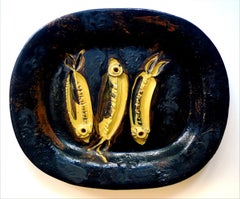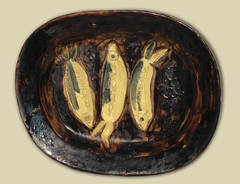Trois Sardines
1940s Modern Sculptures
Ceramic
Recent Sales
20th Century Modern Figurative Sculptures
Acrylic, Ceramic
1940s Modern More Art
Ceramic
People Also Browsed
Vintage 1940s Swedish Scandinavian Modern Chandeliers and Pendants
Blown Glass
Antique Late 19th Century American Musical Instruments
Mahogany
Antique 19th Century French Louis XVI Mantel Clocks
Bronze
Antique 19th Century Chinese Beds and Bed Frames
Gold Leaf
2010s British Louis XV Sofas
Hardwood
Antique Early 1800s French Empire Office Chairs and Desk Chairs
Mahogany
Antique Late 19th Century French Napoleon III Jewelry Boxes
Bronze, Enamel, Ormolu
Vintage 1970s Italian Mid-Century Modern Chandeliers and Pendants
Copper
Antique Late 19th Century French Louis XV Chandeliers and Pendants
Crystal, Bronze
2010s Italian Mid-Century Modern Tables
Wood, Lacquer
Antique 19th Century French Napoleon III Crystal Serveware
Crystal, Ormolu
20th Century French Art Nouveau Inkwells
Crystal, Bronze
Antique Late 19th Century French Belle Époque Cabinets
Marble, Ormolu, Bronze
Antique Early 19th Century Russian Neoclassical Vases
Porcelain
Antique Early 1900s African Colonial Revival Taxidermy
Iron
Antique 19th Century English Regency Sheffield and Silverplate
Sheffield Plate
Pablo Picasso for sale on 1stDibs
One of the most prolific and revolutionary artists the world has ever seen, Pablo Picasso had a tremendous impact on the development of 20th-century modern art. Although he is best known for his association with the Cubist movement, which he founded with Georges Braque, Picasso’s influence extends to Surrealism, neoclassicism and Expressionism.
“Every act of creation is, first of all, an act of destruction,” the Spanish artist proclaimed. In Picasso's Cubist paintings, he emphasizes the two-dimensionality of the canvas, breaking with conventions regarding perspective, foreshortening and proportion. Picasso was inspired by Iberian and African tribal art. One of his most famous pre-Cubist works is Les Demoiselles d’Avignon (1907), a painting considered immoral and shocking at the time for its depiction of nude women whose faces resemble Iberian tribal masks.
Picasso made many portraits in this style, most often of the women in his life, their expressively colored faces composed of geometric shards of surface planes. In Woman in a Hat (Olga), 1935, he painted his first wife as an assemblage of abstract forms, leaving the viewer to decipher the subject through the contrasting colors and shapes. Picasso was a tireless artist, creating more than 20,000 paintings, drawings, prints, ceramics and sculptures. Tracing his life’s work reveals the progression of modern art, on which he had an unparalleled influence.
Browse an expansive collection of Pablo Picasso's art on 1stDibs.
A Close Look at Modern Art
The first decades of the 20th century were a period of artistic upheaval, with modern art movements including Cubism, Surrealism, Futurism and Dadaism questioning centuries of traditional views of what art should be. Using abstraction, experimental forms and interdisciplinary techniques, painters, sculptors, photographers, printmakers and performance artists all pushed the boundaries of creative expression.
Major exhibitions, like the 1913 Armory Show in New York City — also known as the “International Exhibition of Modern Art,” in which works like the radically angular Nude Descending a Staircase by Marcel Duchamp caused a sensation — challenged the perspective of viewers and critics and heralded the arrival of modern art in the United States. But the movement’s revolutionary spirit took shape in the 19th century.
The Industrial Revolution, which ushered in new technology and cultural conditions across the world, transformed art from something mostly commissioned by the wealthy or the church to work that responded to personal experiences. The Impressionist style emerged in 1860s France with artists like Claude Monet, Paul Cézanne and Edgar Degas quickly painting works that captured moments of light and urban life. Around the same time in England, the Pre-Raphaelites, like Edward Burne-Jones and Dante Gabriel Rossetti, borrowed from late medieval and early Renaissance art to imbue their art with symbolism and modern ideas of beauty.
Emerging from this disruption of the artistic status quo, modern art went further in rejecting conventions and embracing innovation. The bold legacy of leading modern artists Georges Braque, Pablo Picasso, Frida Kahlo, Salvador Dalí, Henri Matisse, Joan Miró, Marc Chagall, Piet Mondrian and many others continues to inform visual culture today.
Find a collection of modern paintings, sculptures, prints and other fine art on 1stDibs.

